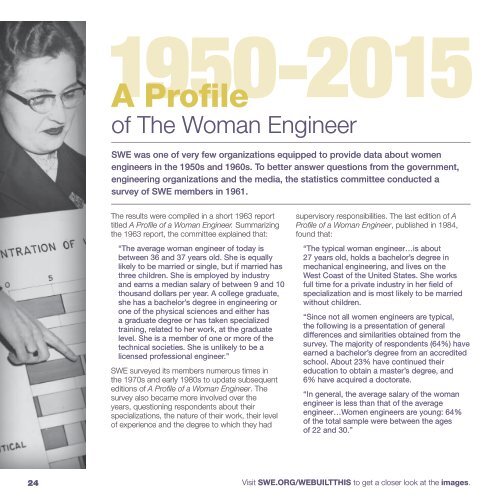THE STORIES
SWE_Webuilthis_Scrapbook_2015
SWE_Webuilthis_Scrapbook_2015
You also want an ePaper? Increase the reach of your titles
YUMPU automatically turns print PDFs into web optimized ePapers that Google loves.
1950-2015<br />
A Profile<br />
of The Woman Engineer<br />
SWE was one of very few organizations equipped to provide data about women<br />
engineers in the 1950s and 1960s. To better answer questions from the government,<br />
engineering organizations and the media, the statistics committee conducted a<br />
survey of SWE members in 1961.<br />
The results were compiled in a short 1963 report<br />
titled A Profile of a Woman Engineer. Summarizing<br />
the 1963 report, the committee explained that:<br />
“The average woman engineer of today is<br />
between 36 and 37 years old. She is equally<br />
likely to be married or single, but if married has<br />
three children. She is employed by industry<br />
and earns a median salary of between 9 and 10<br />
thousand dollars per year. A college graduate,<br />
she has a bachelor’s degree in engineering or<br />
one of the physical sciences and either has<br />
a graduate degree or has taken specialized<br />
training, related to her work, at the graduate<br />
level. She is a member of one or more of the<br />
technical societies. She is unlikely to be a<br />
licensed professional engineer.”<br />
SWE surveyed its members numerous times in<br />
the 1970s and early 1980s to update subsequent<br />
editions of A Profile of a Woman Engineer. The<br />
survey also became more involved over the<br />
years, questioning respondents about their<br />
specializations, the nature of their work, their level<br />
of experience and the degree to which they had<br />
supervisory responsibilities. The last edition of A<br />
Profile of a Woman Engineer, published in 1984,<br />
found that:<br />
“The typical woman engineer…is about<br />
27 years old, holds a bachelor’s degree in<br />
mechanical engineering, and lives on the<br />
West Coast of the United States. She works<br />
full time for a private industry in her field of<br />
specialization and is most likely to be married<br />
without children.<br />
“Since not all women engineers are typical,<br />
the following is a presentation of general<br />
differences and similarities obtained from the<br />
survey. The majority of respondents (64%) have<br />
earned a bachelor’s degree from an accredited<br />
school. About 23% have continued their<br />
education to obtain a master’s degree, and<br />
6% have acquired a doctorate.<br />
“In general, the average salary of the woman<br />
engineer is less than that of the average<br />
engineer…Women engineers are young: 64%<br />
of the total sample were between the ages<br />
of 22 and 30.”<br />
5<br />
ABOVE: As reported in the Society’s 1963 A Profile of a<br />
Woman Engineer survey, on average single SWE members<br />
earned higher salaries than their married peers, particularly<br />
by the end of their careers.<br />
Cover of the first A Profile of a Woman Engineer, published in<br />
1963, based on a 1961 survey of SWE members.<br />
TOP LEFT: Nancy Cross, nuclear engineer at Oak Ridge<br />
National Laboratory, works at her desk, circa 1960s.<br />
MIDDLE LEFT: Cover of the Society’s 1972 edition of A<br />
Profile of a Woman Engineer.<br />
MIDDLE INSET: SWE found in its 1972 edition of A Profile<br />
of a Woman Engineer that 60% of members had no direct<br />
or indirect supervisory responsibilities; 14% reported that<br />
they supervised a team or unit; 11% supervised a project<br />
or section; 10% managed a major department, division or<br />
program; and 5% had general management responsibilities<br />
for their organizations.<br />
BOTTOM LEFT: Engineer Mary Munger from the Pratt &<br />
Whitney Aircraft Division of the United Aircraft Corporation<br />
inspects equipment, circa 1960s.<br />
BACKGROUND PHOTO: SWE President Pat Brown<br />
displays a chart with SWE members’ engineering disciplines<br />
and job responsibilities, taken from the 1963 A Profile of a<br />
Woman Engineer.<br />
24<br />
Visit SWE.ORG/WEBUILTTHIS to get a closer look at the images.<br />
25


